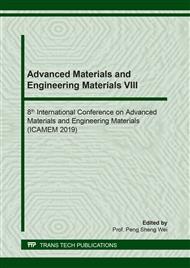[1]
Tseng, K.-H., & Lytton, R. L. Prediction of permanent deformation in flexible pavement materials. Implication of Aggregates in the Design, Construction, and Performance of Flexible Pavements. ASTM STP 1016(1989) 154-172.
DOI: 10.1520/stp24562s
Google Scholar
[2]
Thompson R, M., & Nauman, D. Rutting Rate Analyses of The Aasho Road Test Flexible Pavements. Transportation Research Record. 1384 (1993) 36-48.
Google Scholar
[3]
Guo, Z., Zhang, H., Cong, L., and Gao, Q. Permanent Deformation of Subgrade Soils. Analysis of Asphalt Pavement Materials and Systems. (2007) 156-169.
DOI: 10.1061/40924(308)13
Google Scholar
[4]
Puppala, A. J., Saride, S., & Chomtid, S. Experimental and modeling studies of permanent strains of subgrade soils. Journal of Geotechnical and Geoenvironmental Engineering. 135(10) (2009) 1379-1389.
DOI: 10.1061/(asce)gt.1943-5606.0000163
Google Scholar
[5]
Puppala, A. J., Mohammad, L. N., & Allen, A. Permanent deformation characterization of subgrade soils from RLT test. Journal of Materials in Civil Engineering. 11(4) (1999) 274-282.
DOI: 10.1061/(asce)0899-1561(1999)11:4(274)
Google Scholar
[6]
Li, D. Q., & Selig, E. T. Cumulative plastic deformation for fine-grained subgrade soils. Journal of Geotechnical Engineering-ASCE. 122(12) (1996) 1006-1013.
DOI: 10.1061/(asce)0733-9410(1996)122:12(1006)
Google Scholar
[7]
Muhanna, A. S., Rahman, M. S., & Lambe, P. C. Model for resilient modulus and permanent strain of subgrade soils. Transportation Research Record. 1619(1998) 85-93.
DOI: 10.3141/1619-10
Google Scholar
[8]
Chai, J. C., & Miura, N. Traffic-load-induced permanent deformation of road on soft subsoil. Journal of Geotechnical and Geoenvironmental Engineering. 128(11) (2002) 907-916.
DOI: 10.1061/(asce)1090-0241(2002)128:11(907)
Google Scholar
[9]
Zhao, Y. S., Dennis, N. D., & Elliott, R. P. Prediction of subgrade permanent strain using simple soil properties. Geotechnical Engineering for Transportation Projects. VOL 1(126) (2004)1076-1085.
DOI: 10.1061/40744(154)96
Google Scholar
[10]
Kim, S.-H., Tutumluer, E., Little, D. N., & Kim, N. Effect of gradation on nonlinear stress-dependent behavior of a sandy flexible pavement subgrade. Journal of Transportation Engineering. 133(10) (2007) 582-589.
DOI: 10.1061/(asce)0733-947x(2007)133:10(582)
Google Scholar


